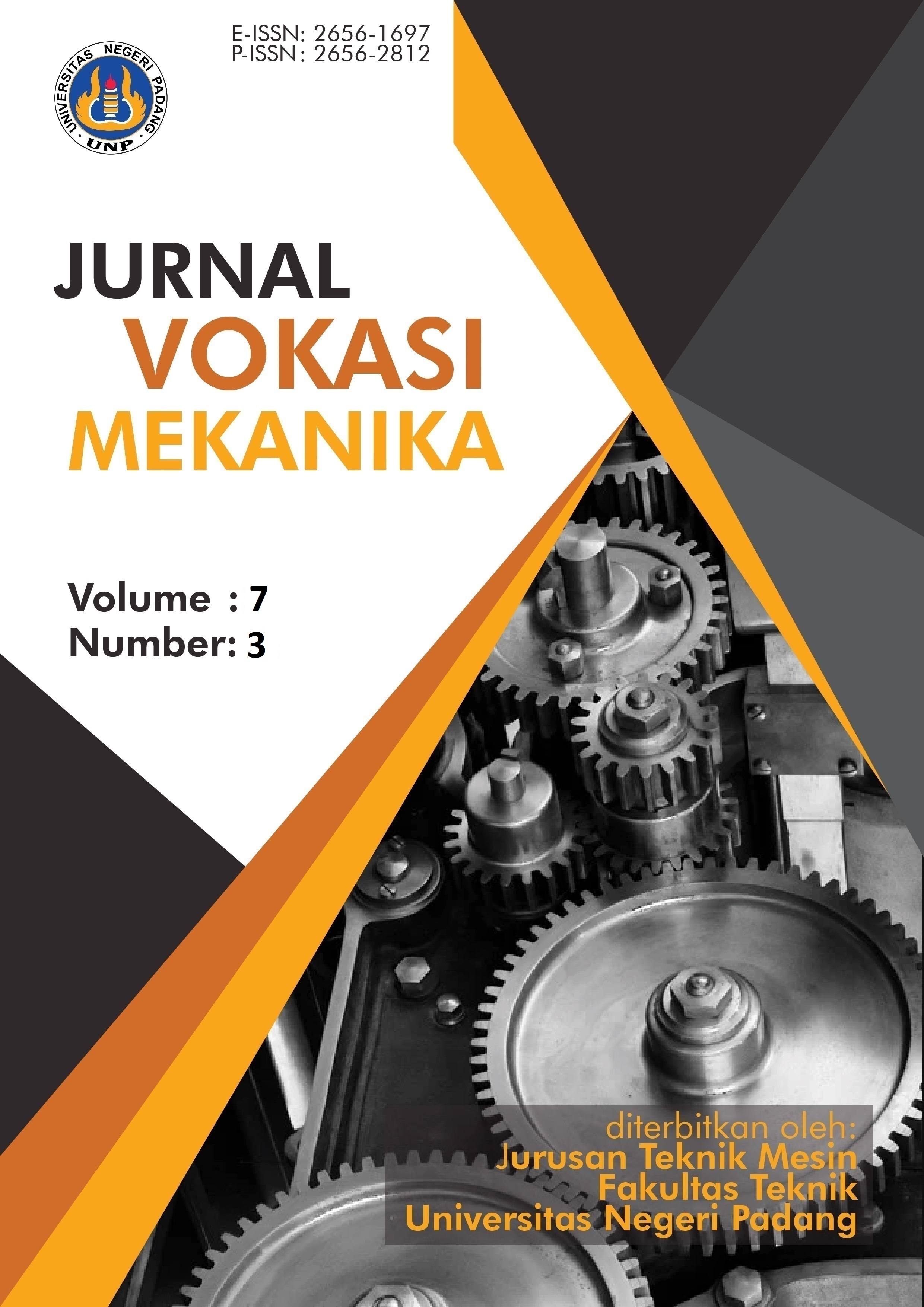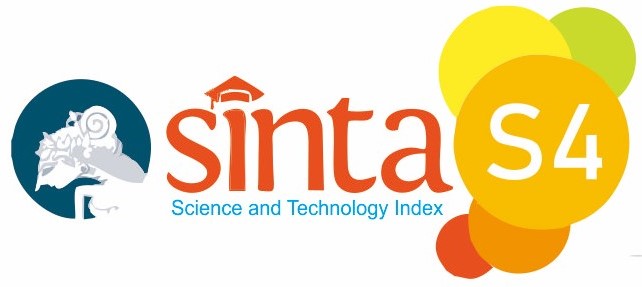Experimental Study of Geometrical Accuracy of Artec Leo 3D Scanner on Complex Object Scanning
Abstract
This study aims to measure the geometrical accuracy of complex object scanning using the Artec Leo 3D scanner. The scanned object is a wheel rim, with eight combinations of parameters including variations in distance (50 cm and 100 cm), scanning angle (45° and 90°), and lighting conditions (indoor and outdoor). Deviations were measured from four reference points on the scanned model and compared to a reference model. The results show that the Indoor configuration with a scanning distance of 50 cm and a scanning angle of 90° gives the smallest deviation of 0.025 mm (0.01%), while the Outdoor configuration with a scanning distance of 50 cm and a scanning angle of 45° produces the largest deviation of -3.275 mm (-1.80%). The overall average deviation of all combinations is -0.63 mm or -0.36%, indicating that the Artec Leo can produce high accuracy if configured with the right parameters. The smallest deviation was obtained under indoor scanning conditions with a scanning distance of 50 cm and a scanning angle of 90°.
References
Ameen, W., Al-Ahmari, A. M., & Mian, S. H. (2018). Evaluation of handheld scanners for automotive applications. Applied Sciences (Switzerland), 8(2). https://doi.org/10.3390/app8020217
Artec Leo 3d. (2022). Manual-Leo-EN (1). https://docs.artec3d.com/leo_/1.8/
BHUYAN, M. A.-U.-A., & GRIFFIN, L. (2020, October 25). Make It Easy: Reliability of Automatic Measurement for 3D Hand Scanning. https://doi.org/10.15221/20.38
Boehnen, C., & Flynn, P. (2005a). Accuracy of 3D Scanning Technologies in a Face Scanning Scenario.
Boehnen, C., & Flynn, P. (2005b). Accuracy of 3D Scanning Technologies in a Face Scanning Scenario.
Chan, B., Rudan, J. F., Mousavi, P., & Kunz, M. (2020). Intraoperative integration of structured light scanning for automatic tissue classification: a feasibility study. International Journal of Computer Assisted Radiology and Surgery, 15(4), 641–649. https://doi.org/10.1007/s11548-020-02129-8
Dijkman, B. A. M., Liberton, N. P. T. J., te Slaa, S., Smit, J. M., Wiepjes, C. M., Dreijerink, K. M. A., Den Heijer, M., Verdaasdonk, R. M., & de Blok, C. J. M. (2024). A comparative study of 3D measuring methods for monitoring breast volume changes. PLoS ONE, 19(6 June). https://doi.org/10.1371/journal.pone.0305059
Helle, R. H., & Lemu, H. G. (2021). A case study on use of 3D scanning for reverse engineering and quality control. Materials Today: Proceedings, 45, 5255–5262. https://doi.org/10.1016/j.matpr.2021.01.828
Huang, X., Zhang, Y., & Xiong, Z. (2021). High-speed structured light based 3D scanning using an event camera. Optics Express, 29(22), 35864. https://doi.org/10.1364/oe.437944
Javaid, M., Haleem, A., Pratap Singh, R., & Suman, R. (2021a). Industrial perspectives of 3D scanning: Features, roles and it’s analytical applications. Sensors International, 2. https://doi.org/10.1016/j.sintl.2021.100114
Javaid, M., Haleem, A., Pratap Singh, R., & Suman, R. (2021b). Industrial perspectives of 3D scanning: Features, roles and it’s analytical applications. Sensors International, 2. https://doi.org/10.1016/j.sintl.2021.100114
Junjie, M., Dan, L., & Zhilong, L. (2017). Application of 3D Laser Scanning Technology in Complex Rock Foundation Design. 3D Research, 8(4). https://doi.org/10.1007/s13319-017-0144-9
Kovalenko, A. (2022). FIXATION AND EXAMINATION OF VOLUMETRIC TRACKS OF FOOTWEAR USING 3D SCANNING TECHNOLOGIES. Criminalistics and Forensics, 67, 465–472. https://doi.org/10.33994/kndise.2022.67.46
Michalíková, M., Bednarčíková, L., Štefanovič, B., Danko, M., Trebuňová, M., & Živčák, J. (2020). HAND 3D SCANNING POSSIBILITIES. Acta Tecnología, 6(4), 105–110. https://doi.org/10.22306/atec.v6i4.88
Polo, M.-E., Cuartero, A., & Felicísimo, Á. M. (n.d.). Study of uncertainty and repeatability in structured-light 3D scanners.
Rudari, M., Breuer, J., Lauer, H., Stepien, L., Lopez, E., Dragu, A., & Alawi, S. A. (2024). Accuracy of Three-dimensional Scan Technology and Its Possible Function in the Field of Hand Surgery. Plastic and Reconstructive Surgery - Global Open, 12(4), E5745. https://doi.org/10.1097/GOX.0000000000005745
SEIFERT, E., & GRIFFIN, L. (2020a, October 25). Comparison and Validation of Traditional and 3D Scanning Anthropometric Methods to Measure the Hand. https://doi.org/10.15221/20.41
SEIFERT, E., & GRIFFIN, L. (2020b, October 25). Comparison and Validation of Traditional and 3D Scanning Anthropometric Methods to Measure the Hand. https://doi.org/10.15221/20.41
Staffenova, K., Rakyta, M., & Binasova, V. (2022). The possibility of using 3D laser scanning as support for reverse engineering. Acta Simulatio, 8(4), 41–45. https://doi.org/10.22306/asim.v8i4.90
Trojnacki, M., Dąbek, P., & Jaroszek, P. (2022). Analysis of the Influence of the Geometrical Parameters of the Body Scanner on the Accuracy of Reconstruction of the Human Figure Using the Photogrammetry Technique. Sensors, 22(23). https://doi.org/10.3390/s22239181
Verykokou, S., & Ioannidis, C. (2023). An Overview on Image-Based and Scanner-Based 3D Modeling Technologies. In Sensors (Vol. 23, Issue 2). MDPI. https://doi.org/10.3390/s23020596
Wang, Y., Zhou, P., Yao, C., Wang, H., & Lin, B. (2024). High accuracy calibration method for multi-line structured light three-dimensional scanning measurement system based on grating diffraction. Optics Express, 32(1), 691. https://doi.org/10.1364/oe.496579
Xu, Q. (n.d.). Modeling 3D geometry using 1D laser distance measurements with application to cylinder for visualization and evaluating surface quality.
Yue, H., Yu, Y., Chen, W., & Wu, X. (2018). Accurate three dimensional body scanning system based on structured light. Optics Express, 26(22), 28544. https://doi.org/10.1364/oe.26.028544
YU, M., CLOET, A., & GRIFFIN, L. (2021a, October 4). 3D Face Scanner Comparison: Visual and Anthropometric Accuracy Analysis. https://doi.org/10.15221/21.41
Submitted
Copyright (c) 2025 Jurnal Vokasi Mekanika (VoMek)

This work is licensed under a Creative Commons Attribution 4.0 International License.








.svg_.png)


